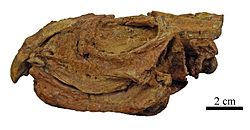| Helsby Sandstone Formation | |
|---|---|
| Stratigraphic range: Middle Triassic | |
 Exposures of Helsby Sandstone Formation at Ladram Bay, Devon, England | |
| Type | Formation |
| Unit of | Sherwood Sandstone Group (SSG) |
| Overlies | Wilmslow Sandstone Formation (disconformity) or Chester Formation (unconformity) |
| Thickness | Up to 500 m |
| Lithology | |
| Primary | sandstone |
| Other | siltstone, mudstone, conglomerate |
| Location | |
| Region | England |
| Country | United Kingdom |
The Helsby Sandstone Formation, formerly known as the Otter Sandstone (in Devon and Somerset), is a geological formation in England. It was deposited during the Anisian stage of the Middle Triassic epoch. It primarily consists of medium to fine grained sandstone, both cross bedded and flat bedded, with minor lenticular beds of siltstone and mudstone and thin beds of conglomerate in some areas. It is found across England, from Devon on the southern coast to Cumbria in the north, with some exposures in Worcestershire and in Staffordshire in the Midlands. [1] It was deposited in a hot, arid climate, when Britain formed part of the Pangean interior [2] [3] with the cross-bedded sandstones of the formation representing remnants of wind-blown sand dunes, [4] while the majority of the formation was produced by the action of braided rivers, specifically the ‘Budleighensis’ river system, which flowed northwards from what is now northern France through southern and central England, before draining into what is now the Irish Sea. The environment of the formation likely also included ponds and small lakes, with surrounding vegetation including conifers (whose roots are preserved as concretions) and horsetails. Towards the top of the formation, the rocks indicate that the conditions became more arid, with the overlying formations showing the disappearance of rivers and the existence of playa-like conditions. [3]
Contents
The formation in its southern coastal exposure in Devon in the vicinity of Sidmouth has provided important fossils of contemporary vertebrates, including temnospondyl amphibians, procolophonid, rhynchosaurian, sphenodontian and archosaurian reptiles, as well as fish. [3]






